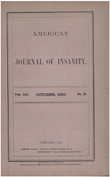Circadian pattern of acute, neuroleptic-induced dystonic reactions
Abstract
OBJECTIVE: This study examined the timing of acute dystonic reactions in 200 patients taking neuroleptic medication for the first time. METHOD: Two hundred patients received a twice-daily regimen of low-dose neuroleptic. RESULTS: Over 80% of the episodes of acute dystonia occurred between 12:00 noon and 11:00 p.m. The observed circadian variation was not accounted for by sleep, fatigue, or time elapsed from the last dose of medication. CONCLUSIONS: The finding of a diurnal pattern in one of the recognized side effects of neuroleptic medication suggests that the therapeutic efficacy of neuroleptics might similarly vary over the course of the day.
Access content
To read the fulltext, please use one of the options below to sign in or purchase access.- Personal login
- Institutional Login
- Sign in via OpenAthens
- Register for access
-
Please login/register if you wish to pair your device and check access availability.
Not a subscriber?
PsychiatryOnline subscription options offer access to the DSM-5 library, books, journals, CME, and patient resources. This all-in-one virtual library provides psychiatrists and mental health professionals with key resources for diagnosis, treatment, research, and professional development.
Need more help? PsychiatryOnline Customer Service may be reached by emailing [email protected] or by calling 800-368-5777 (in the U.S.) or 703-907-7322 (outside the U.S.).



